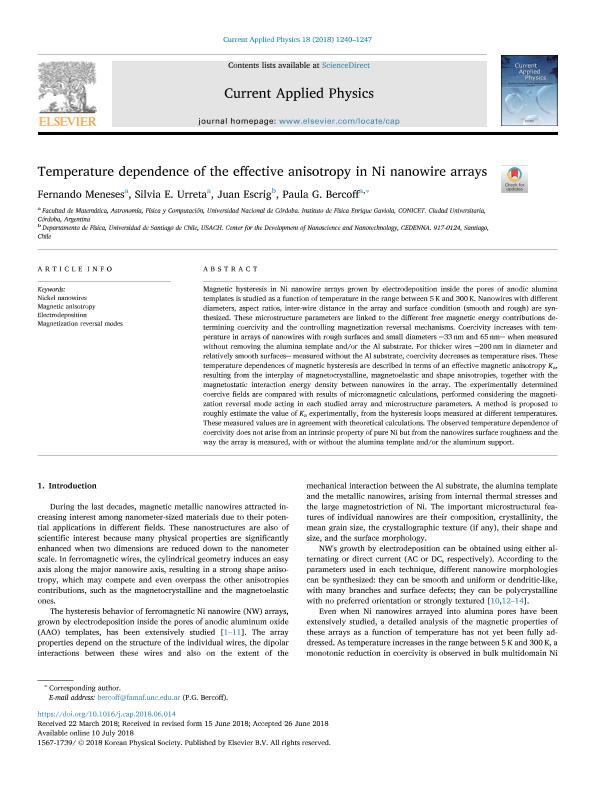Mostrar el registro sencillo del ítem
dc.contributor.author
Meneses, Fernando

dc.contributor.author
Urreta, Silvia Elena

dc.contributor.author
Escrig Murúa, Juan Eduardo

dc.contributor.author
Bercoff, Paula Gabriela

dc.date.available
2019-12-05T22:45:44Z
dc.date.issued
2018-11-10
dc.identifier.citation
Meneses, Fernando; Urreta, Silvia Elena; Escrig Murúa, Juan Eduardo; Bercoff, Paula Gabriela; Temperature dependence of the effective anisotropy in Ni nanowire arrays; Elsevier Science; Current Applied Physics; 18; 11; 10-11-2018; 1240-1247
dc.identifier.issn
1567-1739
dc.identifier.uri
http://hdl.handle.net/11336/91569
dc.description.abstract
Magnetic hysteresis in Ni nanowire arrays grown by electrodeposition inside the pores of anodic alumina templates is studied as a function of temperature in the range between 5 K and 300 K. Nanowires with different diameters, aspect ratios, inter-wire distance in the array and surface condition (smooth and rough) are synthesized. These microstructure parameters are linked to the different free magnetic energy contributions determining coercivity and the controlling magnetization reversal mechanisms. Coercivity increases with temperature in arrays of nanowires with rough surfaces and small diameters ─33 nm and 65 nm─ when measured without removing the alumina template and/or the Al substrate. For thicker wires ─200 nm in diameter and relatively smooth surfaces─ measured without the Al substrate, coercivity decreases as temperature rises. These temperature dependences of magnetic hysteresis are described in terms of an effective magnetic anisotropy Ka, resulting from the interplay of magnetocrystalline, magnetoelastic and shape anisotropies, together with the magnetostatic interaction energy density between nanowires in the array. The experimentally determined coercive fields are compared with results of micromagnetic calculations, performed considering the magnetization reversal mode acting in each studied array and microstructure parameters. A method is proposed to roughly estimate the value of Ka experimentally, from the hysteresis loops measured at different temperatures. These measured values are in agreement with theoretical calculations. The observed temperature dependence of coercivity does not arise from an intrinsic property of pure Ni but from the nanowires surface roughness and the way the array is measured, with or without the alumina template and/or the aluminum support.
dc.format
application/pdf
dc.language.iso
eng
dc.publisher
Elsevier Science

dc.rights
info:eu-repo/semantics/openAccess
dc.rights.uri
https://creativecommons.org/licenses/by-nc-sa/2.5/ar/
dc.subject
ELECTRODEPOSITION
dc.subject
MAGNETIC ANISOTROPY
dc.subject
MAGNETIZATION REVERSAL MODES
dc.subject
NICKEL NANOWIRES
dc.subject.classification
Otras Ciencias Físicas

dc.subject.classification
Ciencias Físicas

dc.subject.classification
CIENCIAS NATURALES Y EXACTAS

dc.title
Temperature dependence of the effective anisotropy in Ni nanowire arrays
dc.type
info:eu-repo/semantics/article
dc.type
info:ar-repo/semantics/artículo
dc.type
info:eu-repo/semantics/publishedVersion
dc.date.updated
2019-10-22T16:36:59Z
dc.journal.volume
18
dc.journal.number
11
dc.journal.pagination
1240-1247
dc.journal.pais
Países Bajos

dc.journal.ciudad
Amsterdam
dc.description.fil
Fil: Meneses, Fernando. Consejo Nacional de Investigaciones Científicas y Técnicas. Centro Científico Tecnológico Conicet - Córdoba. Instituto de Física Enrique Gaviola. Universidad Nacional de Córdoba. Instituto de Física Enrique Gaviola; Argentina. Universidad Nacional de Córdoba. Facultad de Matemática, Astronomía y Física; Argentina
dc.description.fil
Fil: Urreta, Silvia Elena. Consejo Nacional de Investigaciones Científicas y Técnicas. Centro Científico Tecnológico Conicet - Córdoba. Instituto de Física Enrique Gaviola. Universidad Nacional de Córdoba. Instituto de Física Enrique Gaviola; Argentina. Universidad Nacional de Córdoba. Facultad de Matemática, Astronomía y Física; Argentina
dc.description.fil
Fil: Escrig Murúa, Juan Eduardo. Universidad de Santiago de Chile; Chile
dc.description.fil
Fil: Bercoff, Paula Gabriela. Consejo Nacional de Investigaciones Científicas y Técnicas. Centro Científico Tecnológico Conicet - Córdoba. Instituto de Física Enrique Gaviola. Universidad Nacional de Córdoba. Instituto de Física Enrique Gaviola; Argentina. Universidad Nacional de Córdoba. Facultad de Matemática, Astronomía y Física; Argentina
dc.journal.title
Current Applied Physics

dc.relation.alternativeid
info:eu-repo/semantics/altIdentifier/url/https://www.sciencedirect.com/science/article/pii/S1567173918301822
dc.relation.alternativeid
info:eu-repo/semantics/altIdentifier/doi/https://doi.org/10.1016/j.cap.2018.06.014
Archivos asociados
